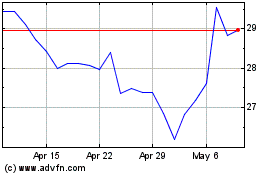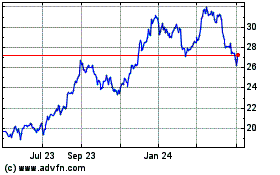The UBS Asset Management US Pension Fund Fitness Tracker saw the
funding ratio of the typical corporate US pension plan drop by
approximately three percentage points to 80% in the second quarter
of 2016.
This Smart News Release features multimedia.
View the full release here:
http://www.businesswire.com/news/home/20160706006009/en/
Source: UBS Asset Management, Barclays,
Markit.
"In a low rate environment, it is tempting to forgo a duration
matching strategy until rates normalize. However, as yields
globally grind toward historic lows, plans with a disciplined LDI
program in place have been rewarded for controlling exposure," said
Frank van Etten, head of Client Solutions at UBS Asset
Management.
The fall in Treasury yields during June caused liability values
to increase in the second quarter of 2016. Investment returns of
2.1% could not keep up with the return on liabilities over the
quarter, causing funding ratios to once again decrease. These
estimates are based on the average corporate plan’s reported asset
allocation weightings from the UBS Asset Management Pension 500
Database and publicly available benchmark information.
The rather unexpected outcome of the recent referendum in the
UK, where voters requested that the UK leave the European Union,
has been the main headline in the financial press. Economic
estimates suggest that the UK will be the country that will lose
most from the voters' decision. Some negative effects in
Continental Europe are likely, while the other continents can
expect minimal impact.
The US economy has continued to thread along without big
surprises. A rather weak employment number in June encouraged the
data-driven Fed to wait a little longer before increasing the
target rate. At least one rate increase, maybe two, before the end
of 2016 is possible because the labor market is tightening, the
fundamentals of the economy remain solid, and inflation is
converging toward the expected range around 2%.
Altogether, the world economy is not in a recession, but keeps
growing below potential. Everyone's focus is on the central banks
because governments have abdicated their role in stabilizing the
economy and fostering economic growth—austerity or plain inactivity
seems to please voters enough to keep incumbents in charge or to
replace them with populists who will serve more of the same.
During the second quarter, equity markets saw mixed returns. The
S&P 500 Index ended the quarter up, with a total return of
2.46%. The Euro Stoxx Total Return Index was down 4.82%, in US
dollar (USD) terms, over the quarter. The MSCI Emerging Markets
Total Return Index ended the quarter only 0.80% higher in USD
terms.
The yield on 10-year US Treasury notes ended the quarter down 30
basis points (bps) at 1.47%. The yield on 30-year US Treasury bonds
decreased 33 bps, ending at 2.28%. High-quality corporate bond
credit spreads, as measured by the Barclays Long Credit A+
option-adjusted spread, ended the quarter 4 bps tighter. As a
result, pension discount rates (which are based on the yield of
high-quality investment grade corporate bonds) decreased over the
quarter. The passage of time caused liabilities for a typical
pension plan to increase by about one percentage point over the
quarter. Together, these effects caused liabilities to increase
6.1% for the quarter. (Please see disclosures for assumptions and
methodology.)
Disclosures and methodology
Funding ratio
Funding ratios measure a pension fund’s ability to meet future
payout obligations to plan participants. The main factors impacting
the funding ratio of a typical US defined benefit plan are equity
market returns, which grow (or shrink) the asset pool from which
plan participants’ benefits are paid, and liability returns, which
move inversely to interest rates.
Liability indices: Methodology
Pension Protection Act (PPA) liability returns are approximated
by the Barclays Capital US Long Credit A-AAA Index. This index
broadly reflects the duration and credit characteristics of the PPA
discount curve that is used to discount expected pension benefit
payments for US defined benefit pension plans.
Asset index: Methodology
UBS Asset Management approximates the return for the ”typical”
US defined benefit plan using the reported asset allocation of the
UBS Asset Management Pension 500 Database. The series is
constructed using the aggregate asset allocation weightings and
publicly available benchmark information, with geometrically linked
monthly total returns.
Pension Fund Fitness Tracker: Methodology
The US Pension Fund Fitness Tracker is the ratio of the asset
index over the liability index. Assuming all other factors remain
constant, it combines asset and liability returns, and measures the
impact of a “typical” investment strategy on the funding ratio of a
model defined benefit plan in the US due to interest rollup, change
in interest rates and typical asset performance, but excludes
unique plan factors, such as service cost and benefit payments. The
impact of changes in mortality tables on liabilities in 2014 and
2015 was estimated to be +6% and -2%, respectively.
The UBS Asset Management Pension 500 Database
The UBS Asset Management Pension 500 Database is a proprietary
database that is based on the analysis of 500 public companies
sponsoring large defined benefit plans. The information was
extracted from the companies’ 10-K statements, and therefore
represents generally accepted accounting principles (GAAP)
information. The study may include figures for companies’
nonqualified and foreign plans, both of which are not subject to
ERISA. The aggregate asset allocation is based on an equally
weighted average of the 500 companies included in the database. The
aggregate asset allocation includes equities, fixed income, hedge
funds, private equity, real estate and cash.
Notes to Editors
About UBS Asset Management
Asset Management is a large-scale asset manager with a presence
in 22 countries. It offers investment capabilities and investment
styles across all major traditional and alternative asset classes
to institutions, wholesale intermediaries and wealth management
clients around the world. It is a leading fund house in Europe, the
largest mutual fund manager in Switzerland, the third-largest
international asset manager in Asia, the second largest fund of
hedge funds manager and one of the largest real estate investment
managers in the world.
About UBS
UBS provides financial advice and solutions to wealthy,
institutional and corporate clients worldwide, as well as private
clients in Switzerland. The operational structure of the Group is
comprised of our Corporate Center and five business divisions:
Wealth Management, Wealth Management Americas, Personal &
Corporate Banking, Asset Management and the Investment Bank. UBS's
strategy builds on the strengths of all of its businesses and
focuses its efforts on areas in which it excels, while seeking to
capitalize on the compelling growth prospects in the businesses and
regions in which it operates, in order to generate attractive and
sustainable returns for its shareholders. All of its businesses are
capital-efficient and benefit from a strong competitive position in
their targeted markets.
UBS is present in all major financial centers worldwide. It has
offices in 54 countries, with about 34% of its employees working in
the Americas, 35% in Switzerland, 18% in the rest of Europe, the
Middle East and Africa and 13% in Asia Pacific. UBS Group AG
employs approximately 60,000 people around the world. Its shares
are listed on the SIX Swiss Exchange and the New York Stock
Exchange (NYSE).
View source
version on businesswire.com: http://www.businesswire.com/news/home/20160706006009/en/
UBS Asset ManagementGregg Rosenberg,
+1-212-713-8842Gregg.rosenberg@ubs.comwww.ubs.com
UBS (NYSE:UBS)
Historical Stock Chart
From Aug 2024 to Sep 2024

UBS (NYSE:UBS)
Historical Stock Chart
From Sep 2023 to Sep 2024
